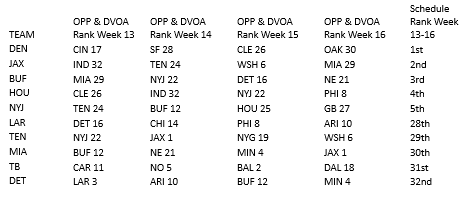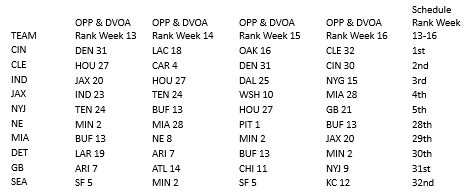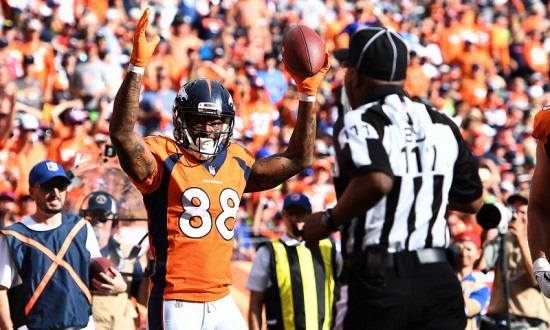Strategies for DRAFT’s $1,000,000 Best Ball Tournament
If you haven’t already seen, DRAFT has rolled out its biggest competition ever (probably – I’m not fact-checking because I’m not a historian).
Don’t have a DRAFT account? Sign up for one TODAY and get a FREE $3 entry when you deposit!
The contest is a 46,080-entry competition with $1,000,00 in prizes and will consist of a 12-week season culminating in four one-week playoffs for those who finish at the top of their respective tournaments. The prize structure is as follows:

As you can see, the prize structure is drastically different in the playoffs, and the final Week 16 round will be a 60-person, one-week tournament with a $100,000 top prize and 60th place paying out $2,000. This tournament structure adds a huge extra level of strategy over the normal Best Ball format and gives huge room for advantage for players who plan accordingly (placing higher emphasis on the latter weeks of the season).
Why Matchups Matter
Obviously, the goal in this tournament is to finish at the top of your draft group after 12 weeks. If you fail to do so, your entry wins nothing. But keep in mind that matchups for Weeks 13-16 can be hugely beneficial, as well. Whenever in a scenario where you are deciding between two different players, you should always give preferential treatment for the player who has better matchups during the tournament playoff weeks (giving even more preferential treatment to Week 16, as it gives you the biggest boost in potential ROI). Using strictly DVOA (I suggest you do further research into each individual player’s matchup), below are the teams the most beneficial and least beneficial matchups for Weeks 13-16:
Passing Matchups Using DVOA

RB Matchups Using DVOA

TE Matchups

Using the DVOA rankings above, you can clearly see that certain teams have much better matchups during the playoff weeks of the tournament than during the regular season. For instance, when trying to decide between drafting Jerick McKinnon in the early rounds or waiting several rounds for either Kenyan Drake or Dion Lewis, it is beneficial to keep in mind that Lewis faces the fourth-easiest run schedule in the playoffs and the 29th-ranked rush defense in Week 16, while Drake faces the third-easiest matchups for Weeks 13-16 and 27th-ranked defense in Week 16. In such a scenario, you’re probably better off drafting a WR or TE in the early rounds over McKinnon and waiting a few rounds for either Drake or Lewis. Keeping matchups in mind as you are drafting can be the key difference between being bounced from the tournament in Week 13 and winning $100,000 in Week 16.
Drafting High-Ceiling WRs
When drafting RBs, you are generally giving priority to a high floor over a high ceiling. This is true because, in general, running backs have higher workloads than that of wide receivers. Even in today’s game, where true feature backs are becoming more and more scarce, running backs tend to see a higher volume of touches than wideouts. One thing that can cause receivers to have a drastically higher variance is deep threat wide receivers.
For instance, let’s look at a few prominent deep threats, T.Y. Hilton and Tyreek Hill. Both have the possibility of going for huge points on low amounts of receptions. Adding to the variance is that wide receivers’ outputs depend greatly on cornerback matchups. A true shutdown corner in the wrong week of the playoffs can greatly limit the ceiling of a WR1 (though to be fair, with the truly top-tier wideouts like Julio Jones, tough cornerback matchups impact their floor more than their ceiling, as they can go off for huge games in any matchup). Keeping these two things in mind and doing research into individual wide receivers’ ceilings and matchups can pay huge dividends in the late rounds of the playoffs.
Stacking QBs/WRs
Generally in Best Ball tournaments, stacking QBs/WRs over the course of the season can affect your ending placement about as much eating a vegetable once a month can have on your chances of living until 90. As you should probably know, in one-week salary format it can be highly beneficial. With this hybrid style of tournament, stacking QBs with WRs can be highly beneficial in the latter rounds while not really affecting you in Weeks 1-12. Add in the fact that you can have multiple QB/WR stacks in the same lineup and your chances of that 150-yard, two-touchdown game from one of your WRs and the 350-yard, three-touchdown game your quarterback become drastically more likely and that much more beneficial in the long run.

With non-elite QBs being drafted in the later rounds of drafts, getting someone like Demaryius Thomas in one of the earlier rounds and pairing him in the late rounds with Case Keenum can be a drastic positive ROI strategy in this best ball tournament. Overall, stacking your QB/WR should be something you don’t go drastically out of your way to do. But given the fact that QBs are so clumped together, it’s worth keeping in mind what wide receivers are on your roster in case his quarterback falls into your lap in the later rounds.
Don’t have a DRAFT account? Sign up for one TODAY and get a FREE $3 entry when you deposit!
Positional Scarcity
One thing to keep in mind in all drafts, regardless of sport, is positional scarcity. As you draft, you can see the average draft position for each player. These can be a valuable resource, but just like in regular season-long fantasy football, some people become way too reliant on these numbers. These numbers represent the ADP for all sort of different drafts (e.g. 3-man, 6-man, 10-man, etc.). In a 4-man draft, getting two or three good QBs is not difficult.
After all, there are 30 starting QBs in the league, and there isn’t a huge gap between fantasy production between the top guy and the 10th guy off the board. In a 12-man draft, however, not all players are even able to draft a third starting QB, making the QB position a scarce resource. The same can be said about TEs, and even RBs, to an extent. In the NFL, while certain teams have up to three viable WRs, some teams may not even have one viable TE (i.e. Arizona, Houston, Seattle)* or RB (i.e. New York Jets, Denver, New England)*
*FYI, these are first-look examples of teams of teams whose TEs and RBs appear to be weak spots. I may very well end up being wrong, but these are the first teams that came to mind, and we’re still two months out so…slow your roll.
Figuring out how many players to draft in a 12-man draft is entirely dependent on how much depth you believe each position to have, but in my opinion, there is much more depth at the WR position then there is at any other position in a 12-man draft (meaning I prioritize other positions ahead of WR in the middle rounds of the $1,000,000 Best Ball tournament).
Using The Flex
One of the things you need to keep in mind when figuring out how much depth you want to have at each position is that there is a flex position. While you only have two RB slots, three WR slots, and one TE slot, any of these positions can be used to fill your one flex slot. So, keeping in mind that RBs and TEs are far more susceptible to injury each week, it can be advantageous to draft an extra RB or TE, knowing that they can fill the flex spot in any given week.
Benefits of 3 QBs
A lot of people will preach that drafting a third QB is not as beneficial as an extra RB or WR because of the marginal changes in points between QBs. In a 12-man best ball, where there is a semi-playoff system, this is simply not the case; it is extremely important to prioritize drafting a third QB. First, if you have a QB injured during the playoff dates, having a third QB can be drastically beneficial. Second, having a QB who will be out for the first few games, such as Andrew Luck or Jameis Winston, can hurt your team far more than a WR or RB who isn’t getting any points you’ll use during the playoff format. Finally, having a third QB can allow you to stack multiple different ways with your wide receivers which drastically raises your ceilings during the tournament’s one-week playoff.
Notes for the Lazy
If you don’t like to read, or if your kids are screaming at you because there’s some random ladybug flying around the living room and if you don’t look soon then the entire world may come to an end (something I once claimed as a five-year-old because I was fat and wanted attention), then there are the five things you need to keep in mind when drafting in this tournament.
1. Pay attention to what defense players will be playing during the “Playoff” weeks of the Best Ball tournament, placing even more emphasis on the final week where it’s a 60-man playoff and the marginal difference in prizes become more drastic the higher you place.
2. Stacking a QB with one of your WRs in the later rounds can be hugely beneficial in the playoff format, especially if the stack is in a positive defensive matchup in those weeks.
3. Some positions are scarcer than others, and in 12-man drafts, you’re always in danger of ending the season with bad players at certain positions, which can ruin your team.
4. Floors and ceilings for WRs are even more important in this format.
5. Drafting three QBs can be beneficial in this format in case one of yours is injured during one of the playoff weeks, and drafting three TEs or five RBs can be beneficial both because injuries are more common with them and because they can still be used in the flex position.
Don’t have a DRAFT account? Sign up for one TODAY and get a FREE $3 entry when you deposit!